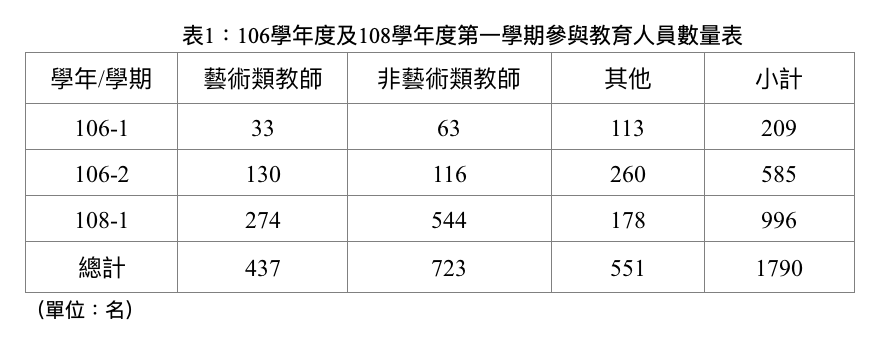Specific results of the first semester of the 108th academic year
1. Regional ratio and quantity
The participating schools in this project are located all over Taiwan, with 86 primary schools, 65 secondary schools, and 2 special education schools, totaling 153 schools.

Enter108After the new semester of the school year, this plan will re-adjust the districts to make the number of schools in each district more balanced. From the figure1It can be seen that the plans produced by each district are roughly average.
If we look at each stage, as shown in the figure3As shown, the total output of primary school students is92software solutions, accounting for approximately59%;Medium stage output61software solutions, accounting for approximately39%;Output of special education stage2pieces, approximately2%;Total actual receipts155Course plans.

The ratio at the primary school level is relatively high. In addition to the originally larger number of primary schools, this time there are6Pay between schools2The above-mentioned programs are all for the primary school level, which is one of the factors contributing to the high ratio of primary school students.
2. Educators participating in cross-disciplinary aesthetic education projects
Educators involved in the development and implementation of cross-field aesthetic course programs. After this project entered a new phase, the number of participants has increased significantly, as shown in Table 1.

All participants can be divided into art teachers, non-art teachers and others. Other categories include principals, directors, school administrators or external lecturers, etc. Among them, the largest increase was for non-art teachers. It can be seen that the promotion of aesthetic education does not distinguish between disciplines, and more and more non-art teachers are willing to invest in the development of cross-field aesthetic courses.
3. Participating students and teaching hours
After entering the first semester of the 108 academic year, the number of students participating in the cross-field aesthetic courses can be seen from Table 2. There were 13,218 students in the 105 academic year. By the first semester of the 108 academic year, 19,021 students had participated. The number of participants in one semester alone is more than the number of participants in the past year, which shows the high growth of the number of people.

Judging from the class levels of participating students in the first semester of the 108th academic year, most of them implement cross-field aesthetic education courses in ordinary classes, but there are still a few in classes such as art classes, gifted classes, resource classes, and physical education classes. Details As shown in Figure 4.

In terms of teaching hours, as shown in Figure 5, the number of teaching hours in the first semester of the 2018 academic year has increased sharply to 7,049 hours. It can be seen that in addition to more students participating, the time they spend participating in cross-field aesthetic courses has also increased a lot.

4. Curriculum plan across subjects
The cross-disciplinary aesthetic courses aim to integrate subjects in the art field with other disciplines, explore the co-preparation and co-teaching between fields, enable students to develop core competencies between different disciplines, and inspire the ability to integrate. From this point on, all interdisciplinary aesthetic courses are interdisciplinary designs. The calculation method for the number of cross-disciplinary subjects is as follows: assuming that the cross-disciplinary subjects of a certain curriculum plan are visual arts, mathematics and Chinese language, the number of cross-disciplinary subjects is 3 subjects. The cross-subject number of the course plan for the first semester of the Statistics 108 academic year is shown in Figure 6:

During the 105-106 academic year, the rate of students crossing 2 subjects was higher, accounting for 39%, followed by those crossing 3 subjects, accounting for 27%. By the first semester of the 2018 academic year, the majority were students who spanned more than five subjects (inclusive), followed by those who spanned three subjects. It can be seen that as the project progresses, the teachers in the seed schools have become more and more skilled in cross-subject teaching, and are more willing to try more cross-field aesthetic teaching in more subjects.
5. Integration of subjects in the art field into the curriculum plan
The core concept of the cross-disciplinary aesthetic course is to integrate the teaching of other disciplines with artistic concepts, aesthetic elements and artistic resources, etc., as media, resources and strategies to activate and assist subject learning to construct "arts-centered" (arts-core) based) courses. Therefore, the integration of subjects in the art field is also one of our focuses.
Because there are interdisciplinary situations in the art field, if one school's curriculum plan is to integrate visual arts and music, and another school combines music and performing arts, the statistical method will be 1 subject for visual arts, 2 subjects for music, and 2 subjects for performing arts. Category 1 subject, subtotal the number of each subject and then make a percentage with the number of all course plans in the planning stage.

In terms of the integration situation in the art field, as shown in Figure 8, visual arts are the largest category, followed by music and performing arts.
6. Integration of subjects into curriculum plan
In the implementation of cross-field aesthetic courses, in addition to subjects in the art field, the integration of disciplines is also a major focus. The cross-field model helps combine many disciplines with the field of art, allowing students to understand the meaning in a more diversified education method. meaning and application methods.
This statistics is based on the fields shown in the syllabus. Each curriculum plan can span more than 2 subjects, and the maximum number of subjects is summed. For example, in a school, transnational languages, history, geography, and information are counted as language fields. 1 subject, 2 subjects in the social field, and 1 subject in the information field. As shown in Figure 9, it can be seen that the subject integration situation in the first semester of the 2018 academic year is that the Chinese field accounts for the most 27%, followed by the natural field accounting for 16%, and the social field accounts for 15%.




